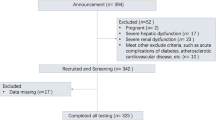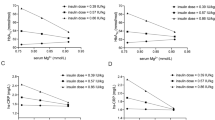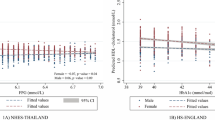Abstract
Objective
To evaluate the role of PhA in diabetes in a large population of older adults with a high prevalence of diabetes in order to gain new insights on the potential diagnostic and prognostic role of PhA in individuals with diabetes.
Design
Cross-sectional study.
Setting
Teaching Hospital.
Participants
1085 individuals aged 55 years or over.
Measurements
Phase Angle was obtained using bioimpedance analysis with the Bodystat QuadScan® 4000. Diabetes mellitus was considered present with fasting hyperglycaemia (serum fasting glucose >6.66 mmol/l), HbA1c > 42 mmol/mol (6.1%), or self-reported Diabetes or the consumption of glucose-lowering agents.
Results
The mean age of the (standard deviation) of the 1,085 participants was 68.11 (7.12) years and 60.7% were women. Among male participants, individuals with PhA within the lowest quartile (PhA ≤4.9) were significantly more likely to have diabetes mellitus [odds Ratio (95% confidence interval, CI), 2.02 (1.17–3.47)] following adjustments for age, body mass index and other comorbidities. The above relationship was attenuated following further adjustment hypoglycaemic medications. Men on oral hypoglycaemic agents had significantly reduced PhA [mean difference (95% CI), −0.44 (−0.67 to −0.22)]. No significant relationship between PhA and diabetes existed among women.
Conclusion
The association between lower PhA (≤4.9) in men aged 55 and over and diabetes which is accounted for by oral hypoglycaemic agents. The mechanisms underlying this relationship remain unclear. This relationship should also be evaluated further to determine the potential of PhA as a prognostic tool for diabetes.
This is a preview of subscription content, access via your institution
Access options
Subscribe to this journal
Receive 12 print issues and online access
$259.00 per year
only $21.58 per issue
Buy this article
- Purchase on Springer Link
- Instant access to full article PDF
Prices may be subject to local taxes which are calculated during checkout
Similar content being viewed by others
References
Wan Nazaimoon WM, Md Isa SH, Wan Mohamad WB, Khir AS, Kamaruddin NA, Kamarul IM, et al. Prevalence of diabetes in Malaysia and usefulness of HbA1c as a diagnostic criterion. Diabet Med. 2013;30:825–8. https://doi.org/10.1111/dme.12161.
Ogurtsova K, da Rocha Fernandes JD, Huang Y, Linnenkamp U, Guariguata L, Cho NH, et al. IDF diabetes atlas: global estimates for the prevalence of diabetes for 2015 and 2040. Diabetes Res Clin Pr. 2017;128:40–50. https://doi.org/10.1016/j.diabres.2017.03.024.
Guariguata L, Whiting DR, Hambleton I, Beagley J, Linnenkamp U, Shaw JE. Global estimates of diabetes prevalence for 2013 and projections for 2035. Diabetes Res Clin Pr. 2014;103:137–49. https://doi.org/10.1016/j.diabres.2013.11.002.
Park SW, Goodpaster BH, Strotmeyer ES, Kuller LH, Broudeau R, Kammerer C, et al. Accelerated loss of skeletal muscle strength in older adults with type 2 diabetes. Diabetes Care. 2007;30:1507 https://doi.org/10.2337/dc06-2537.
McPherron AC, Guo T, Bond ND, Gavrilova O. Increasing muscle mass to improve metabolism. Adipocyte. 2013;2:92–98. https://doi.org/10.4161/adip.22500.
Kyle UG, Bosaeus I, De Lorenzo AD, Deurenberg P, Elia M, Gómez JM, et al. Bioelectrical impedance analysis—part I: review of principles and methods. Clin Nutr. 2004;23:1226–43.
Wilhelm-Leen ER, Hall YN, Horwitz RI, Chertow GM. Phase angle, frailty and mortality in older adults. J Gen Intern Med. 2014;29:147–54. https://doi.org/10.1007/s11606-013-2585-z.
Garlini LM, Alves FD, Ceretta LB, Perry IS, Souza GC, Clausell NO Phase angle and mortality: a systematic review. Eur J Clin Nutr 2018. https://doi.org/10.1038/s41430-018-0159-1.
Norman K, Stobaus N, Pirlich M, Bosy-Westphal A. Bioelectrical phase angle and impedance vector analysis-clinical relevance and applicability of impedance parameters. Clin Nutr. 2012;31:854–61. https://doi.org/10.1016/j.clnu.2012.05.008.
Lukaski HC, Kyle UG, Kondrup J. Assessment of adult malnutrition and prognosis with bioelectrical impedance analysis: phase angle and impedance ratio. Curr Opin Clin Nutr Metab Care. 2017;20:330–9. https://doi.org/10.1097/mco.0000000000000387.
Dittmar M, Reber H, Kahaly GJ. Bioimpedance phase angle indicates catabolism in Type 2 diabetes. Diabet Med. 2015;32:1177–85. https://doi.org/10.1111/dme.12710.
Jun M-H, Kim S, Ku B, Cho J, Kim K, Yoo H-R, et al. Glucose-independent segmental phase angles from multi-frequency bioimpedance analysis to discriminate diabetes mellitus. Sci Rep. 2018;8:648 https://doi.org/10.1038/s41598-017-18913-7.
Buffa R, Mereu E, Comandini O, Ibanez M, Marini E. Bioelectrical impedance vector analysis (BIVA) for the assessment of two-compartment body composition. European J Clin Nutrition. 2014;68:1234–1240.
Bosy-Westphal A, Danielzik S, Dörhöfer RP, Later W, Wiese S, Müller MJ. Phase angle from bioelectrical impedance analysis: population reference values by age, sex, and body mass index. JPEN J Parenter Enter Nutr. 2006;30:309–16. https://doi.org/10.1177/0148607106030004309.
Lim LM, McStea M, Chung WW, Nor Azmi N, Abdul Aziz SA, Alwi S, et al. Prevalence, risk factors and health outcomes associated with polypharmacy among urban community-dwelling older adults in multi-ethnic Malaysia. PLoS One. 2017;12:e0173466 https://doi.org/10.1371/journal.pone.0173466.
Bonora E, Tuomilehto J. The pros and cons of diagnosing diabetes with A1C. Diabetes Care. 2011;34:S184–S190. https://doi.org/10.2337/dc11-s216. Suppl 2
Buchholz AC, Bartok C, Schoeller DA. The validity of bioelectrical impedance models in clinical populations. Nutr Clin Pract. 2004;19:433–46.
Tanaka S, Ando K, Kobayashi K, Seki T, Hamada T, Machino M, et al. Low bioelectrical impedance phase angle is a significant risk factor for frailty. BioMed Res Int. 2019;2019:6283153 https://doi.org/10.1155/2019/6283153.
Rosas-Carrasco O, Ruiz-Valenzuela RE, López-Teros MT. Phase angle cut-off points and their association with sarcopenia and frailty in adults of 50–64 years old and older adults in Mexico city. Front. Med. 2021. https://doi.org/10.3389/fmed.2021.617126.
Buscemi S, Blunda G, Maneri R, Verga S. Bioelectrical characteristics of type 1 and type 2 diabetic subjects with reference to body water compartments. Acta Diabetol. 1998;35:220–3.
Rena G, Hardie DG, Pearson ER. The mechanisms of action of metformin. Diabetologia. 2017;60:1577–85. https://doi.org/10.1007/s00125-017-4342-z.
Migdal A, Yarandi SS, Smiley D, Umpierrez GE. Update on diabetes in the elderly and in nursing home residents. J Am Med Dir Assoc. 2011;12:627–32.
Schroeder EB, Bayliss EA, Daugherty SL, Steiner JF. Gender differences in cardiovascular risk factors in incident diabetes. Women’s Health issues: Off Publ Jacobs Inst Women’s Health. 2014;24:e61–8. https://doi.org/10.1016/j.whi.2013.09.008.
Acknowledgements
The MELoR study is now the Transforming Cognitive Frailty to Later Life Self-Sufficiency (AGELESS) study, which was funded by the Ministry of Higher Education Malaysia Long Term Research Grant Scheme (LR005–2019) LRGS/1/2019/UM//1/1.
Author information
Authors and Affiliations
Contributions
Conceived and/or designed the work that led to the submission, acquired data, and/or played an important role in interpreting the results.-FI, SBK, MPT, MM. Drafted or revised the manuscript. SM, MPT. Approved the final version. SM, FI, SBK, MPT, MM. Agreed to be accountable for all aspects of the work in ensuring that questions related to the accuracy or integrity of any part of the work are appropriately investigated and resolved SM, FI, SBK, MPT, MM.
Corresponding authors
Ethics declarations
Competing interests
The authors declare no competing interests.
Additional information
Publisher’s note Springer Nature remains neutral with regard to jurisdictional claims in published maps and institutional affiliations.
Rights and permissions
About this article
Cite this article
Mat, S., Tan, M.P., Mohktar, M.S. et al. Phase angle and diabetes in community-dwelling older adults: cross-sectional analysis from the Malaysian elders longitudinal research (MELoR) study. Eur J Clin Nutr 76, 680–684 (2022). https://doi.org/10.1038/s41430-021-01020-2
Received:
Revised:
Accepted:
Published:
Issue Date:
DOI: https://doi.org/10.1038/s41430-021-01020-2
This article is cited by
-
Association of bio-impedance phase angle and a nutritional indicator in community-dwelling patients with type 2 diabetes mellitus
Journal of Diabetes & Metabolic Disorders (2023)



